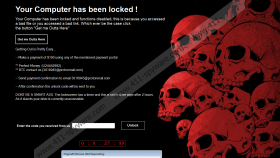BlackKnight2020 Ransomware Removal Guide
When BlackKnight2020 Ransomware invades your Windows operating system, it immediately launches a full-screen window that makes it impossible for you to access your system normally. You can reboot it to safe mode/safe mode with networking if you need to get in fast, or you can read our report to learn how to unlock the screen-locker. Hopefully, once you take care of that, you will be able to delete BlackKnight2020 Ransomware from your system yourself, but know that you are not obligated to remove this malware manually. There are other options to consider, and we discuss them in this report also. Besides providing you with important information about the infection, we are also ready to answer any questions that might pop up while you are reading. The comments section is open, and you can post all questions anonymously.
BlackKnight2020 Ransomware is identified as a screen-locker ransomware. This tells you a lot. First of all, the main function of this malware is to lock your screen, and most infections do that using full-screen windows. To ensure that you cannot bypass this window easily, the threat BlackKnight2020 disables the Explorer and hides the Task Manager. Therefore, even if you figure out quickly that you need to terminate a malicious file and then delete the associated .exe file, doing that is not so simple. The threat is also identified as ransomware because after taking over your screen, it pushes you to pay a ransom. In some ways, this infection is comparable to Wholocked Ransomware, ComputerDestroyer Ransomware, "Microsoft detected an unsolveable Therat" Locker, and other dangerous ransom-demanding threats.
Our research has revealed that Windows users are most likely to encounter BlackKnight2020 Ransomware when interacting with misleading spam emails. Ideally, you would ignore spam completely, but if the subject line is believable, if the message is convincing, and if it is not identified as spam by your email provider, you could be fooled. A file attachment or a link represented via the message could lead to the execution of BlackKnight2020 Ransomware, which is why you have to be very mindful when interacting with strange emails and especially the files and links represented via them. Once the threat is executed, it immediately “locks” the screen by introducing a full-screen black window with an intimidating image of red skulls. Along with this image, a message is displayed, and it starts with a declaration that the computer was locked “because you accessed a bad file or […] link.”
The “Get me Outta Here” button introduced within the message expands it and offers more details. According to them, the computer will be “unlocked” as soon as you pay a ransom of $100. To pay the ransom, you are offered to choose between Perfect Money or Bitcoin. In either case, you are also asked to send a message to 3816945@protonmail.com. All of this is risky. If you email the attackers, they will push you to pay the ransom, and they could also send you new misleading emails. And if you pay the ransom, it goes straight into the pocket of the attackers, and they do not even need to assist you further. The good news is that you do not need to take any of these risks; you can just use this Unlock password.
Unlock password: BlackKnight2020
Unlocking the system should not be hard. If the password does not work, you have to reboot to Safe Mode and remove BlackKnight2020 Ransomware files to disable the lock. Unfortunately, removing this malware can be kind of tricky. The name of the launcher file could be completely unique, and we cannot tell you where this file could be dropped for execution. If you can identify the malicious file, remove it ASAP. If you cannot do that, employ a tool that will do it automatically. A legitimate anti-malware tool is the right one for the job, and we recommend installing it if you need help protecting your system too. Note that as long as it remains unguarded, it will remain the target of ransomware, trojans, and all other kinds of threats.
How to delete BlackKnight2020 Ransomware
- Use the BlackKnight2020 password to unlock the screen.
- Locate the {unknown name}.exe file that launched the infection.
- Right-click the malicious file and choose Delete.
- Empty Recycle Bin and then install a trusted malware scanner.
- Perform a full system scan to examine the system for leftovers.
BlackKnight2020 Ransomware Screenshots:


